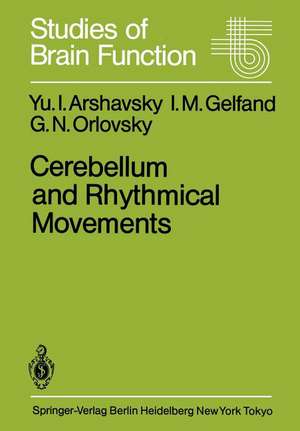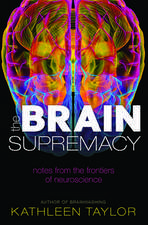Cerebellum and Rhythmical Movements: Studies of Brain Function, cartea 13
Autor Y. I. Arshavsky, I. M. Gelfand, G. N. Orlovskyen Limba Engleză Paperback – 17 noi 2011
Din seria Studies of Brain Function
- 15%
 Preț: 631.72 lei
Preț: 631.72 lei - 15%
 Preț: 636.45 lei
Preț: 636.45 lei - 15%
 Preț: 647.73 lei
Preț: 647.73 lei - 15%
 Preț: 584.58 lei
Preț: 584.58 lei - 18%
 Preț: 784.13 lei
Preț: 784.13 lei -
 Preț: 394.51 lei
Preț: 394.51 lei - 15%
 Preț: 641.71 lei
Preț: 641.71 lei - 15%
 Preț: 640.06 lei
Preț: 640.06 lei - 15%
 Preț: 641.71 lei
Preț: 641.71 lei - 15%
 Preț: 639.41 lei
Preț: 639.41 lei - 15%
 Preț: 642.03 lei
Preț: 642.03 lei - 18%
 Preț: 721.63 lei
Preț: 721.63 lei - 15%
 Preț: 640.24 lei
Preț: 640.24 lei - 15%
 Preț: 632.37 lei
Preț: 632.37 lei - 15%
 Preț: 638.24 lei
Preț: 638.24 lei - 15%
 Preț: 639.41 lei
Preț: 639.41 lei
Preț: 383.33 lei
Nou
Puncte Express: 575
Preț estimativ în valută:
73.35€ • 76.78$ • 61.05£
73.35€ • 76.78$ • 61.05£
Carte tipărită la comandă
Livrare economică 31 martie-14 aprilie
Preluare comenzi: 021 569.72.76
Specificații
ISBN-13: 9783642708305
ISBN-10: 3642708307
Pagini: 184
Ilustrații: XI, 166 p.
Dimensiuni: 170 x 244 x 10 mm
Greutate: 0.3 kg
Ediția:Softcover reprint of the original 1st ed. 1986
Editura: Springer Berlin, Heidelberg
Colecția Springer
Seria Studies of Brain Function
Locul publicării:Berlin, Heidelberg, Germany
ISBN-10: 3642708307
Pagini: 184
Ilustrații: XI, 166 p.
Dimensiuni: 170 x 244 x 10 mm
Greutate: 0.3 kg
Ediția:Softcover reprint of the original 1st ed. 1986
Editura: Springer Berlin, Heidelberg
Colecția Springer
Seria Studies of Brain Function
Locul publicării:Berlin, Heidelberg, Germany
Public țintă
ResearchCuprins
I Spinal Mechanisms of Stepping and Scratching Movements.- 1. Crucial Role of the Spinal Cord in Control of Stepping and Scratching Movements.- 2. Preparations and Evoking of Movements.- 3. Hindlimb Movements and Muscle Activity.- 4. Role of Central Mechanisms and Afferent Signals in Generating Rhythmic Movements.- 5. Afferent Signals.- 6. Localization of the Rhythm Generator. Activity of Neurons of the “Leading” Region of the Lumbo-Sacral Spinal Cord.- 7. Conclusion.- II Signals Coming to the Cerebellum.- 1. Cerebellar Cortex and its Afferent Connections.- 2. Dorsal Spino-Cerebellar Tract.- 3. Ventral Spino-Cerebellar Tract.- 4. Spino-Reticulo-Cerebellar Pathway.- 5. VSCT and SRCP convey Messages about Activity in the “Leading” Region of Lumbo-Sacral Cord.- 6. Spino-Olivo-Cerebellar Pathway.- 7. Conclusion.- III Signals Conveyed by Descending Tracts.- 1. Vestibulo-Spinal Tract.- 2. Reticulo-spinal Tract.- 3. Rubro-Spinal Tract.- 4. Influences of Descending Tracts upon Motor Activity.- 5. Conclusion.- IV Role of Different Input Signals for Generating Cerebellar Output Signals.- 1. Role of Signals Concerning Peripheral and Central Processes During Locomotion.- 2. Role of Signals Concerning Peripheral and Central Processes During Scratching.- 3. Role of Signals Coming via VSCT and SRCP.- 4. Conclusion.- V Activity of Cerebellar Neurons.- 1. Purkinje Cells.- 2. Fastigial Nucleus.- 3. Interpositus Nucleus.- 4. Lateral Nucleus.- 5. Conclusion.- VI External Inputs of the Spino-Cerebellar Loop.- VII Role of the Cerebellum in the Control of Locomotion and Scratch Reflex.- References.














